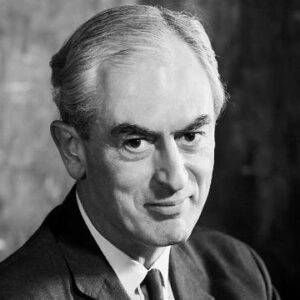Sir Peter Brian Medwar, a British biologist of Brazilian descent, was awarded the Nobel Prize in Physiology or Medicine for his discovery of the concept of “acquired immunological tolerance.” He shared this award with Sir Frank Macfarlane Burnet in 1960. His invention of the theory contributed to the discovery of a method that made tissue and organ transplantation possible in the future. Sir Frank hypothesized that shortly after birth, all animals acquire the ability to distinguish between internal and external factors. This notion was accepted by Medawar, even though it contradicted the preceding theory that vertebrates have this ability from the moment of conception. He demonstrated that skin grafts from one twin might be accepted by the other since both twins possessed the same antigens essential for the development of immunity. This discovery transformed the fundamental concept of immunology by suggesting that a fully developed immune system can be modified to prevent the rejection of foreign organs and tissues. During the Second World War, his research on the rejection of skin grafts for a growing number of burn victims inflicted by German bombers became an extremely important subject.
Youth and Early Life
Peter Medawar was born in Petropolis, Brazil on February 28, 1915, 40 miles from Rio de Janeiro. His father, Nicholas Agnatius Medawar, was a Lebanese salesman, while his mother, Edith Muriel Dowling, was an Englishwoman.
He was the second of his parents’ children. His older sibling was named Phillip.
After moving to England with his family in 1928, he attended Marlborough College from 1928 to 1932, where he developed a fascination for biology.
In 1935, he earned a bachelor’s degree in zoology with honors from Magdalen College, Oxford.
He was named Christopher Welch Scholar and Senior Demonstrator at Magdalen College in 1935.
From 1946 to 1947, he was re-elected as a ‘Fellow of Magdalen College,’ and in 1947, he was issued a D.Sc. due to his inability to pay the Ph.D. completion fee.
Peter Medawar’s Career
After completing his bachelor’s degree, Peter Medawar spent time working at the Sir William Dunn School of Pathology.
In 1935, he became a Christopher Welch Scholar and Senior Demonstrator at Magdalen College.
His initial scientific work on connective tissue cells was conducted in 1937, but it was not well received despite having a significant impact on his later investigations.
In 1938, he was elected a Fellow of Magdalen, a position he held until 1944.
He continued at Oxford during the Second World War, becoming a “Rolleston Prizeman” in 1942, a “Senior Research Fellow of St. John’s College,” and the university’s demonstrator of zoology in 1944.
During World War II, he conducted studies on transplanting tissues, particularly skin, in the ‘Burns Unit’ of the ‘Glasgow Royal Infirmary’.
1943, while working at the ‘Burns Unit’ of the ‘Glasgow Infirmary’ for the ‘War Wounds Committee of the ‘British Medical Council,’ he and Thomas Gibson published a report on the rejection process of skin grafts.
He demonstrated that the patient’s body took ‘autografts’ from the burn victim’s other body parts more readily than ‘homografts’ or ‘allografts’ derived from a different individual. This indicated that the issue was more biological than surgical in nature.
After the war ended, he continued his investigations and around this time came across the idea and experiments of Frank Macfarlane Burnet, an Australian immunologist who originally proposed the theory of “acquired immunological tolerance.”
In 1947, he was appointed the “Mason Professor of Zoology” at the “University of Birmingham” and relocated there.
In 1947, he collaborated with Leslie Brent and Billingham to organize a study group.
From 1947 to 1951, he was a professor of zoology at the University of Birmingham.
From 1951 to 1962, he held the position of “Jodrell Professor of Zoology and Comparative Anatomy” at University College, London.
He was the director of London’s National Institute of Medical Research from 1962 until 1971.
He served as the head of the Medical Research Council’s clinical research facility at Harrow, which was involved in skin transplantation, from 1971 until 1986.
From 1977 until 1983, he worked at the Royal Institution on experimental medicine.
In 1981, he was appointed president of the Royal Postgraduate Medical School, a position he held until 1987.
Peter’s Major Opera
1957 saw the publication of “The Uniqueness of the Individual,” followed by 1959’s “The Future of Man.”
His next book, The Art of the Soluble, was published in 1967, followed by “The Hope of Progress” in 1972, “The Life Science” in 1977, and “Pluto’s Republic” in 1982.
In 1986, he published his memoir, “Memoir of a Thinking Radish.”
Awards & Achievements
Peter Medawar was named “Fellow of the Royal Society of London” in 1949 and awarded the “Royal Medal” in 1959.
In 1958, he received the C.B.E. or “Commander of the British Empire” medal.
In 1960, he got the Nobel Prize.
In 1965, he obtained his knighthood.
In 1972, he was granted the C.H. or “Companion of Honor,” and in 1981, he was awarded the O.M. or “Order of Merit.”
Personal History and Legacy
In February 1937, he wed Jean Shingle-wood Taylor, and the couple had four children.
In 1969, while making a speech, he suffered his first stroke, which left him disabled.
He suffered numerous more strokes in the years that followed. Peter Medawar died of a stroke on October 2, 1987, in London, United Kingdom.
Estimated Net Worth
Peter is one of the wealthiest and most popular zoologists in the world. According to our research, Wikipedia, Forbes, and Business Insider, Peter Medawar has an estimated net worth of $1.5 million.


